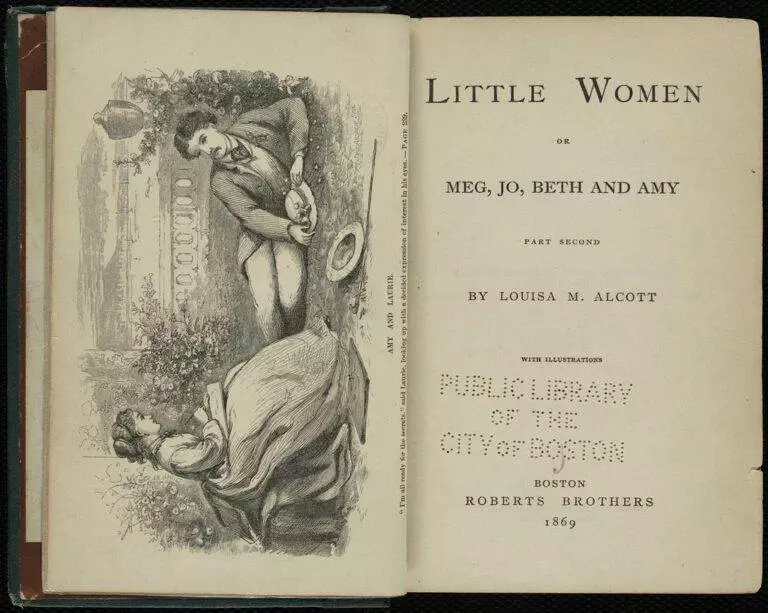Published in 1868, Little Women by Louisa May Alcott is a classic coming-of-age novel about the four March sisters – Meg, Jo, Beth, and Amy – growing up in New England during the Civil War. Drawing on Alcott’s own childhood, it captures the joys and struggles of adolescence with enduring warmth and poignancy. Though set in a particular historical period, its exploration of family, love, ambition, and finding one’s place in the world continues to resonate with readers across generations.
Table of Contents
Plot Summary
Set in the fictional town of Concord, Massachusetts, the novel opens in the March household with the four sisters enduring wartime scarcity but keeping their spirits up. Marmee and Father March urge the girls to cherish family and fight pettiness. The elder March sisters work to support their family while youngest Amy is still in school. Boy next door Laurie befriends Jo and joins the sisters’ various creative plays and adventures.
As the girls grow older, they face their own insecurities and dreams. Jo rejects Laurie’s marriage proposal, free-spirited Amy goes abroad, gentle invalid Beth’s health declines, and oldest sister Meg begins her married life. When Aunt March passes away, timid Beth inherits her mansion Plumfield. Though Beth dies tragically, her spirit brings the family closer. The novel ends happily with Meg having twins, Amy marrying Laurie, and Jo inheriting Plumfield where she can fulfill her dreams.
Themes and Analysis
Some major themes depicted in the novel are:
- Growing up and transition from childhood to maturity
- Bonds of family and sisterhood through good and bad times
- Women balancing societal expectations with personal ambitions
- Cultivating one’s talents and discovering a vocation
- Cherishing small joys and virtues like kindness in hard times
- Trials of poverty and illness amid the Civil War

Alcott skillfully develops each March sister into a fully-drawn character with unique struggles. Little Women balances lighthearted moments with life’s serious challenges. The sisters serve as archetypes but each defies gender stereotypes in different ways. Alcott conveys the passage of time to underscore how events shape the girls’ personalities as they come of age.
Louisa May Alcott and Her Times
Louisa May Alcott grew up in Massachusetts as an abolitionist Transcendentalist whose family associated with Emerson and Thoreau. Her unconventional upbringing informed her progressive views.
Key historical context:
- Expectations for women to marry and nurture families
- Civil War creating economic hardship and deaths
- Transcendentalism’s influence valuing conscience over convention
- Rise of women’s education, involvement in causes like abolition
- Alcott’s family at center of intellectual Concord community
- Publishing open to women both as writers and predominant readers
Drawing from her lively intellectual family, Alcott wrote vivid stories often focused on sisters. She became renowned for children’s literature.
Analysis of Major Characters
Jo March – The bookish aspiring writer and heroine loosely based on Alcott. Her hot temper and ambition contrast traditional femininity.
Beth March – The piano-playing peacemaker of the family whose shy sweetness binds the sisters together. She falls ill with scarlet fever.

Amy March – The youngest sister, pretty but rather spoiled and vain initially. She grows into a proper lady abroad.
Meg March – The family beauty who finds domestic happiness in marriage and motherhood. She represents ideal genteel womanhood.
Laurie Laurence – The lonely rich boy next door who becomes like a brother to the Marches but struggles to find his calling.
Marmee March – The strong matriarch and minister’s wife who guides her daughters with compassion. She represents ideal motherhood.
Read These Too:
Influence and Significance
As a renowned novel focused on girls’ experiences, Little Women has greatly impacted culture:
- Beloved classic that established stories about girls for young female readership.
- Jo March one of the most influential tomboyish independent heroines.
- Inspired “march” and “little” in titles of numerous girls fiction series.
- Sentimental domestic dramas were popularized by its success.
- Encouraged feminization of American children’s literature in late 19th century.
- Its wholesome family values appealed to mainstream America.
- Deeply influential on women authors like Laura Ingalls Wilder who wrote girls fiction.
- Marmee set the archetype for wise maternal figures supporting daughters.
- Adaptations like films and plays made it an enduring part of pop culture.
- Introduced more realism and maturity as girls’ fiction evolved beyond moralistic tales.
Why Read Little Women
Here are some of the key reasons for its enduring impact:
- Loving, emotional portrait of family and girlhood.
- Jo March’s character and journey to independence.
- Brilliant characterizations of the sisters, Marmee and Laurie.
- Blend of lighthearted domesticity with serious drama.
- Historical insights into the American Civil War home front.
- Themes of family, love, ambition resonate through time.
- Social commentary on gender expectations and roles.
- Alcott’s vivid, accessible writing style.
- Powerful emotional moments around tragedy and growth.
- Satisfying coming-of-age narrative.
Conclusion
Louisa May Alcott’s warm novel about love, sisterhood and growing up still feels timeless over 150 years later. The March sisters confront universal challenges and aspirations. Largely inspired by Alcott’s own adolescence, Little Women retains an authenticity that has enchanted countless readers and ignited imaginations across generations. A American literary treasure, it remains a heartfelt portrait of family in times of hardship and an ode to girls on the cusp of womanhood.



1 Comment
Pingback: "Little Women": Sisterhood in Louisa May Alcott's Timeless Classic - LitGram by MukeshRishit